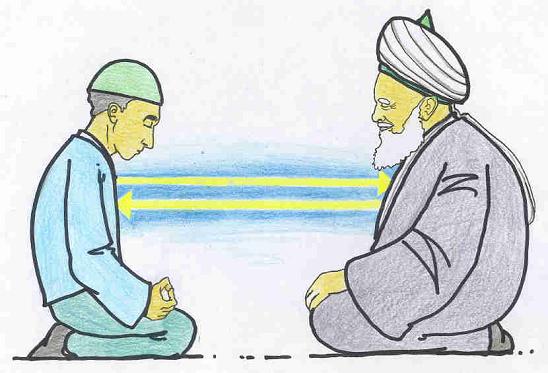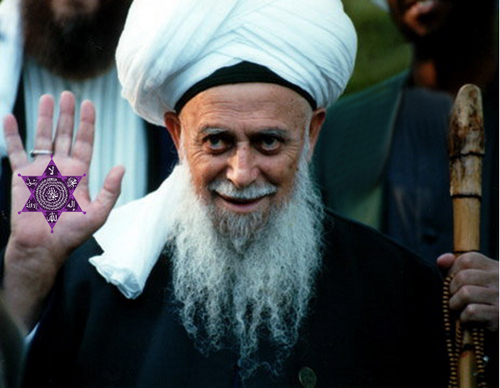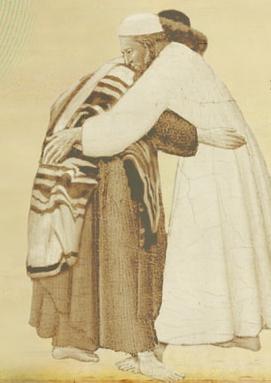
My Goal is to unite the 12 Tribes of Israel (as referenced in the Torah Genesis 29:32 - 30:24) with the 12 Tribes of Ishmael (ibid. Genesis 25:12-16) in unity to worship the God of Abraham, Ishmael and Isaac, called Allah or Elohim (each in their own respective language, Arabic and Hebrew. Linguistically, it is the same name for the same God.)
What is a Hebrew Sufi? It all starts with Abraham. Abraham was called the first Hebrew (Eevreet) in the Torah. This was because he was told to cross over the river Euphrates from the land of idolatry (Babylon) to the Promised Land, The Holy Land. Abraham, being the founder of the Hebrew Religion, the first monotheistic religion, had a universal message calling everyone to the worship of the ONE unseen God (Allah or Elohim). He had two sons and a grandson that carried on with this message of monotheism (Ishmael, Isaac, and Jacob). Jacob had 12 sons which became the 12 Tribes of Israel, of which I am a descendant.
Amongst the Israelites, God sent thousands and thousands of Prophets. And these Prophets taught the Israelites the worship of the ONE God, His Laws, and how to purify their hearts (Tasawuf) to become closer to God and to be at one with the ONENESS of the One God (Tawheed). They taught how God does not have a mother or a son. God is not a man or the son of man (Numbers 23:19). (Also, Exodus 33:20, "And He said: 'Thou canst not see My face, for man shall not see Me and live.'" He does not incarnate to the flesh like the Hindu Avatars or Greek gods. The Creator is not a part of his creation! He is not made up of many parts. They also taught that everybody is responsible for their own sins!
Amongst the Arabs, in Pre-Islamic Arabia, from the descendents of Prophet Ishmael, were a group of monotheists called Hanifs. From this group of Hanifs, a direct descendent of Ishmael, came Prophet Muhammad. The Prophet came calling the Arabs back to the religion of their ancestors (Abraham and Ishmael) in submission to the One God (Al Islam). For the Arabs were the only other people on earth besides the Hebrews, that even though the majority of them had fallen into idolatry, they still practiced circumcision as had been passed down to them from Ishmael over 2600 years earlier. Prophet Muhammad also taught those who submitted themselves to God (Muslims) how to purify their hearts (Tasawuf). From these Muslims who testified to the Oneness of God and the Prophethood of Muhammad, some pursued this science of purification and became what is called Sufis.
This science of tasawuf was passed down from master to disciples through the centuries. Different masters formed devotional orders (tarîqât) in the early Middle Ages to carry on the message. To enter the way of Sufism, the seeker begins by finding a master, as the connection to the master is considered necessary for the growth of the disciple. The master, to be genuine, must have received the authorization to teach (ijazah) from another Master of the Way, in an unbroken succession (silsilah) leading back to Sufism's origin with the Prophets. It is the transmission of the divine light (Nur) from the teacher's heart to the heart of the disciple, rather than of worldly knowledge transmitted from mouth to ear, that allows the disciple to progress. In addition, the genuine teacher will be utterly strict in his adherence to the Divine Law (Shariah or Halachah). Different devotional styles and traditions developed over time, reflecting the perspectives of different masters and the accumulated cultural wisdom of the orders. Typically all of these concerned themselves with the understanding of subtle knowledge (gnosis), education of the heart to purify it of baser instincts, the love of God, and approaching God through a well-described hierarchy of enduring spiritual stations (maqâmât) and more transient spiritual states (ahwâl). Between the 13th and 16th centuries CE, Sufism produced a flourishing intellectual culture throughout the Islamic world, a "Golden Age" for both Muslims and Jews.
The Sufi message is really that of all the Prophets of God; to purify ourselves physically and spiritually to get closer to the Oneness of God. To become one with His oneness and to be enveloped in His Love, to see the beauty in His creation. The Sufis preserved The Way (Deen) of the ancient Prophets. There were many practices of the Prophets lost to the Israelites (Jews) due to their persecutions, suffering, and exile from the Land of Israel; first during the Babylonian Exile in 586 BCE and then later in the Roman Exile in 135 CE. Examples of these practices include full ablutions (washing the arms, face, and feet) before prayer, raising of the hands in supplication, standing in rows, and profuse prostrations during prayer.
Skip to 13th Century Egypt and Rabbi Abraham Maimonides (1186-1237), son of the famous Moses Maimonides (The Rambam), was the Nagid (leader) of the Jewish Community of Egypt, inheriting the position from his father. He tried to reinstitute these lost practices of the Prophets and the science of self-purification, to feel at one with the Oneness of God, back into mainstream Judaism. He articulated his beliefs in his work entitled Kitab Kifayat Al-Abidin (A Comprehensive Guide for the Servants of God). In this work he articulates The Mystical Path (Tariqa As-Sufia / Derech Ha-Hasidut). He considered himself a Jewish Sufi and was in close contact with the Muslim Sufis. Abraham himself says; “Do not regard as unseemly our comparison of that to the behavior of the Sufis, for the latter imitate the Prophets (of Israel) and walk in their footsteps, not the Prophets in theirs.” (Kifayat Al-Abidin II, p. 320, trans. P. Fenton in The Treatise of the Pool, p. 8).
Elsewhere he declares, "Thou art aware of the ways of the ancient saints of Israel, which are not or but little practiced among our contemporaries, that have now become the practice of the Sufis of Islam, on account of the iniquities of Israel..." Ibid., p.266.
And also, "Observe then these wonderful traditions and sigh with regret over how they have been transferred from us and appeared amongst a nation other than ours whereas they have disappeared in our midst. My soul shall weep...because of the pride of Israel that was taken from them and bestowed upon the nations of the world." Ibid., p.322.
And lastly, "Take heed...not to confuse innovated doctrines and practices with ancient ones, which after having been neglected and forgotten, have been revived and restored, such as the question of prostration under discussion. Indeed, prostration is a halakhic obligation and ancient Jewish rite, which because of the exile, has been abandoned for numerous years. Now that its obligatory nature has been realized and adopted by some [i.e. the Jewish-Sufis]. it appears to the unversed and ignorant as a new religious practice, whereas in fact it is a renewal only in respect of the intermediate period, and not in relation to time of the original Jewish rite." (Jewish Mystical Leaders of the 13th Century, p. 148.)
From the 7th to 13th centuries, 90 percent of Jews lived in Muslim Lands. Jews spoke and wrote in Arabic, wore Arab dress, and had Arabic names. Islamic lands were "the heart of sophisticated culture" -- where philosophy, math, science, poetry, astronomy, etc. flourished. 'The dark ages' were really a period when Christian Europe was in the dark ruled by the Roman Catholic Church...it was the age of light for Jews and Muslims. Examples include Maimonides (Ibn Maimun) and Averoes (Ibn Rushd). The famous Muslim liberator who fought the ruthless bloodthirsty Catholic Crusaders, Salaudeen, had a Jewish Physician, Moses Maimonides. And later, in 1492, when the Catholics expelled the Jews and Muslims from Spain, the Muslim Ottoman ruler Sultan Beyazid II (1481-1512), welcomed the Jews into his empire. The sultan is said to have exclaimed: "Ye call Ferdinand a wise king; he who makes his land poor and ours rich!" at the Spanish monarch's lack of wisdom.
The Sufis preserved the beliefs and practices of the Ancient Prophets of Israel. And by Jews following Sufi Practice, they were getting back to their roots such as the practices of Meditation and Dhikr (the remembrance of God and His names). Thus Abraham Maimonides established a Jewish Sufi Tariqa (path) that kept all the Laws of the Torah and reinstituted the mysticism and spirituality of the Prophets. In addition, the Sufis had a universal message like Prophet Abraham; calling all people to the worship of the ONE God. Famous Sufis include Al Ghazali, Rumi, and Ibn Arabi. The Sufi message could be heard in Morocco, Tunisia, Egypt, Damascus, Palestine, Baghdad, Basra, Persia, and Turkey amongst others.
While some Muslim groups got carried away with politics or absent-minded ritual obsessed with ONLY performing the 5 pillars of Islam, without any spirituality, the Sufis kept their focus on spirituality and closeness to God, while adhering to the Shariah of the Qur’an and the Sunnah (Way of the Prophet).
So in summation, if one were to practice the path of Abraham and the Prophets and those Sages whom preserved this Holy Path, they would be called Hebrew Sufis. To be a true Sufi, one must learn the science of Tasawuf (purification of the heart) from a Sufi Master who has Ijazah (authorization to teach from his master) and his Silsila (unbroken chain of spiritual masters) must go all the way back to the Prophets as can be seen from this example of the Haqqani Naqshbandi Tariqa.. Below are pictures of Shaykh Nazim Adil al-Qubrusi, Leader of the Haqqani Naqshbandi Sufi Tariqa (Order).
For more on the subject of Jewish Sufis, please read: THE MAIMONIDES OF CAIRO: FIVE GENERATIONS OF JEWISH/SUFIS
and Shalom/Salaam: The Story of a Mystical Fraternity
Please click here for more links on Jewish Sufis....



